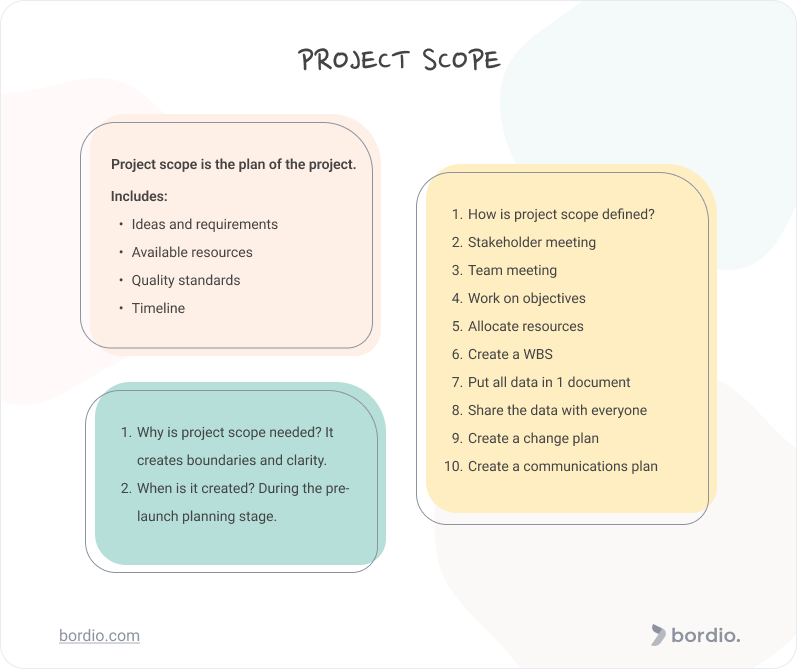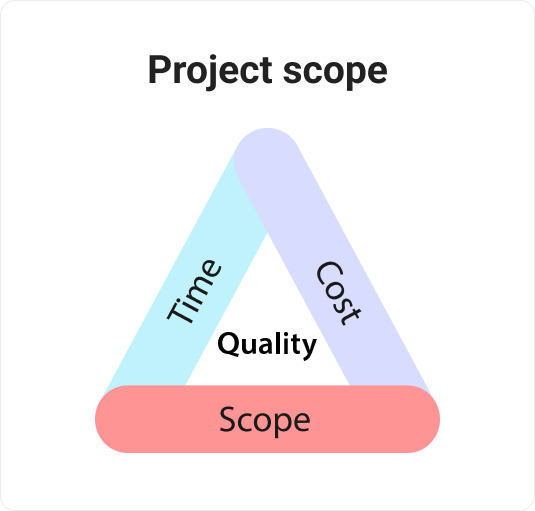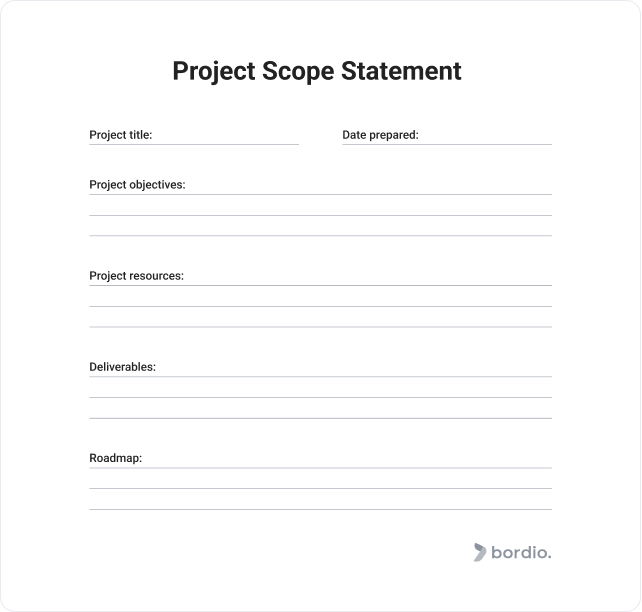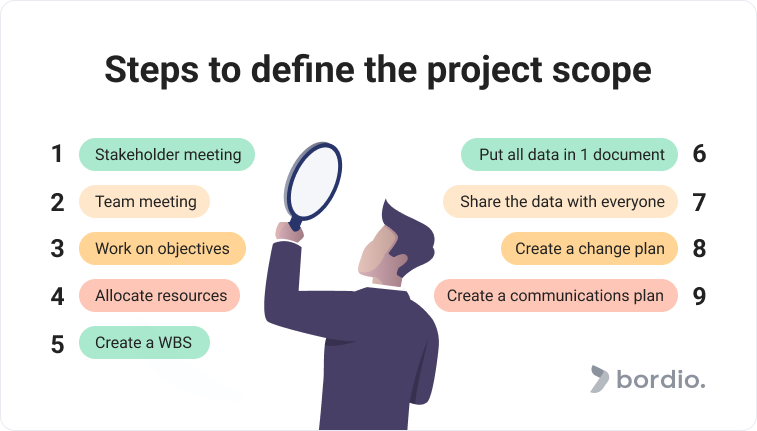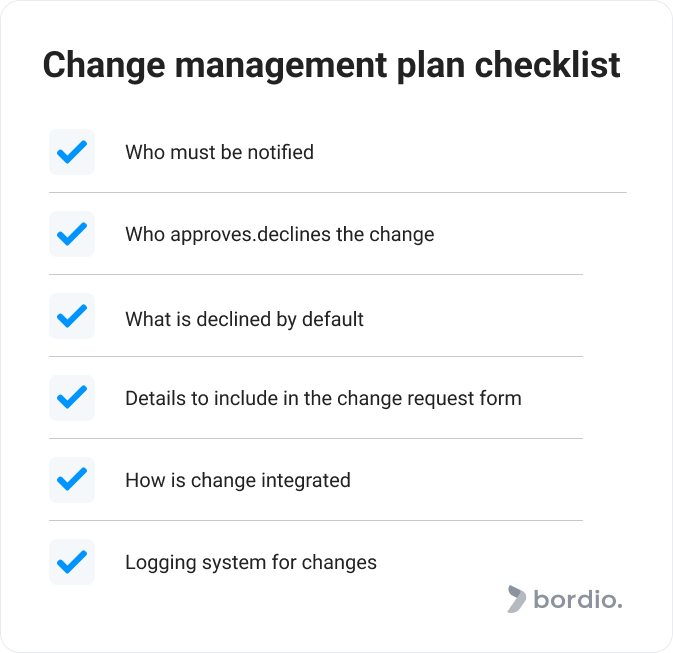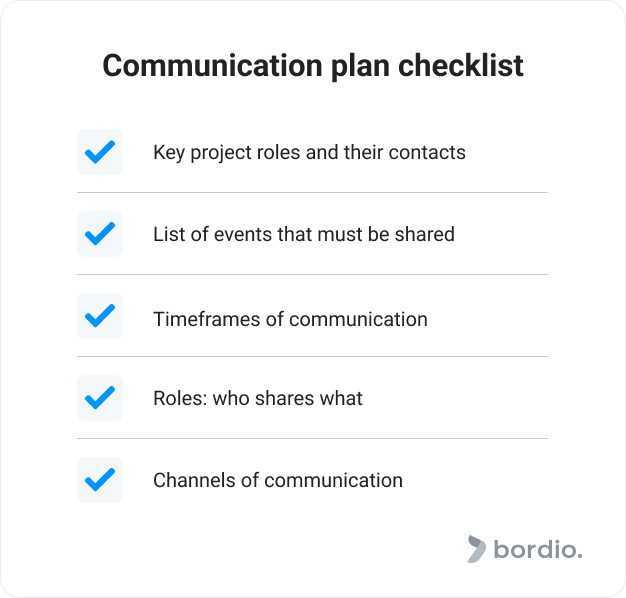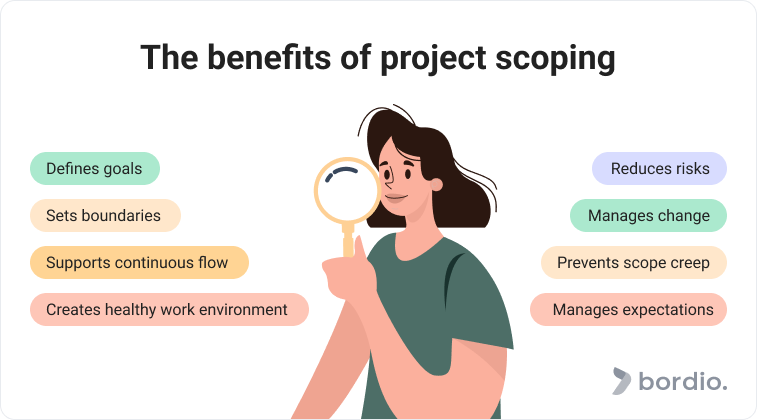When you work on a project, one of the keys to success is aiming for an ambitious but achievable goal.
How does one do that? By preparing a project scope management plan before launching the project.
Project scope is the plan of the project and its combined entity. It includes ideas and requirements, available resources, quality standards, and a timeline. The project scope creates boundaries and removes any ambiguity. It is estimated and analyzed during the pre-launch planning stage.
Project Scope Statement example
The findings and conclusions of the exercise are usually written down in the project scope statement which is essentially a document that contains all scope-related information. Sometimes the scope statement is included in the project implementation plan as a dedicated section, or it can be a self-sufficient document.
There is really no limit on the project scope statement format. It’s fine as long as it works for your situation and includes all the details.
Here is a simplified example of what the scope statement can look like for a house construction project:
Project objectives: Build a house for a family of 5 people.
Project resources:
- Human: construction site supervisor and a team of builders (5) available for up to 50 h/week for 8 weeks; 1 architect available for 20 h/week for week 1 and week 8 of the project.
- Time: 6 months until the interior design team has to take over.
- Finances: 300 000 USD.
Deliverables:
- A complete house ready for interior works.
- All utilities (water, electricity, heating) are connected and fully functioning.
Roadmap:
Week 1: finalizing the architect’s plan and getting the remaining approvals with the council.
Week 2: doing the basement and utilities.
Weeks 3: putting up walls.
Week 4-6: building the roof, windows, and doors.
Week 7: working on remaining tasks.
Week 8: approving the work with the architect and signing off.
What else can you add to the project scope?
Our example features the core elements of any project scope: objectives, resources, deliverables, and roadmap.
However, depending on your preference, the project scope can also include:
- Project milestones that signify achievements or other important events in the project worth mentioning or celebrating and put them into task planner calendar.
- Project assumptions: any thoughts or initial ideas that the team might have before the project started. Could be used for later reference to see if the assumptions turned out to be true or not. You can keep them in work management tool.
- Anything outside of the scope that the team deems (in)directly relevant to the project.
- Acceptance criteria that will be used to evaluate deliverables and approve or decline the project.
- Project risks. A selection of the highest impact most likely risks can be included in the scope statement. Although we certainly hope there won’t be much to include as the project management team will be able to eliminate and mitigate most of them. To easily track progress and risks, use different tools like time management tools.
How to define project scope? A step by step instruction
First of all, it’s important to understand that this is a team effort. Other stakeholders’ expertise and experience will help you finish the work faster, consider more perspectives than you would have yourself, do a better risk management analysis, and ace your change management plan.
Step 1: stakeholder meeting
Run sessions with key stakeholders and identify their requirements and expectations, and acceptance criteria. It is important to start with that step, as it will be a basement for everything else in your project planning.
Tip: Start with small ice breakers to help everyone in the room relax a little bit and help your discussion be more friendly and less bureaucratic. Stakeholders have a huge influence on the project, so you better make them allies from the start.
Step 2: team meeting
Discuss preliminary info from stakeholders with the team to ensure their plans are doable. Schedule extra follow-up meetings in your online calendar planner for example in Bordio’s digital planner daily or discussions if necessary.
Step 3: work on objectives
List all project objectives in your digital to-do list in the online task maker. Big or small, all deliverables that are expected must be written down. Next, have them approved by all stakeholders.
Step 4: allocate resources
Identify how many resources across all categories the project requires and match it with the current situation.
If there’s a resource shortage, plan how that will be compensated. Write down the plan for how all resources will be allocated to ensure there are no double-bookings along the way.
It’s important to stick to the project budget and make sure you have some wiggle room funds set aside for emergencies.
Pro tip 1: Work through your resources situation before moving on to creating action plans and assigning tasks to ensure you know exactly what’s available to you and don’t make any planning mistakes down the line.
Pro tip 2: Approve the resource allocation plan with stakeholders.
Step 5: create a work breakdown structure
A work breakdown structure (WBS) involves outlining what tasks and activities throughout the project lifecycle should be performed, by who, and in which order.
Depending on the project management framework, it might not be necessary to assign task owners at this stage, but having a general idea of who can take care of what would be useful.
A WBS is typically created by the project manager in cooperation with the development team. To find out what else project managers are responsible for, read the what does a PM do article.
Step 6: put together a single scope document
Pile all estimations and calculations together in a single project scope statement. Share it with everyone involved in the project (directly or not) and get the final approvals.
It’s very important to not launch the project before the approvals are in place. Otherwise, you will open yourself up to all kinds of speculations and complications.
Step 7: sharing is caring
Upload the scope statement somewhere where everyone can access it 24/7, like in your project management software of choice. By the way, Bordio has countless features and tools for project managers, such as best electronic planners and online time managers, so make sure you check it out!
And that’s it! You have successfully gone through the project scope management process! Keep it close and refer to the document as the project goes on. Because you’ve approved each and every aspect of it with stakeholders and the team, it will be a great reference point for progress checks and also conflict situations resolution.
We have two bonus steps for you that are not always included in the project scope statement but we believe they fit right in:
Bonus step 1: create a change management plan
Review and approve the change management plan with the team and stakeholders before any work starts.
What to include in your change management strategy:
- Who needs to be notified about the change.
- Who approves and declines change requests.
- What changes are unacceptable by default.
- What should be included in the change request form.
- The approximate process of change integration.
- How all change requests are logged and tracked.
Bonus step 2: design a communication plan
This step by all means can be done later in the project life cycle. However, we would recommend doing it as you are working through your project scope statement for that extra clarity layer. Plus, once you’re done with the project scope, you will want to start crunching your tasks and not have to go back to planning.
We did a whole Guide on communication plan in projects, so make sure to check it out for more detail. Here are the key points that you should include in the plan using simple task maker:
- Key project roles and their contact details.
- What events and news should be shared.
- How often and how quickly something must be communicated.
- Communication roles: who shares what.
- Channels of communication.
You might think a whole separate communication plan is overkill. However, communication is one of the most critical things in projects. In fact, we’d go as far as saying that communication is a project management tool on its own.
One must be conscious about delivering information on time, accurately, and to the right people. Otherwise, you will face the risk of delaying the task, having it executed incorrectly, or upsetting the key stakeholders which we all know should be avoided at all costs.
Tip: Add a recurring task to your digital weekly planner to run a quick check on communication health within the project. Take this time to sit back, remember everything you’ve seen or been reported about, any obstacles that the team experienced because of poor communication, etc. Work out if anything has to be addressed and changed, and take action. So also check out Bordio’s weekly schedule maker.
Why is project scope required?
Project scope helps envision the entire project and create a tangible document in the form of the project scope document where all project-related matters are clearly outlined.
Figuring out the project scope early on has many benefits:
Defines goals
You will be surprised how many projects are launched with no clear goals, milestones, and project deliverables.
Project managers are often rushed to get things going already without an idea of what the final destination will look like. And when that happens, projects end up going through much more turmoil than they would have with a proper plan in place. And a lot of such projects fail, so we don’t want to add to that statistics.
Sets boundaries
We all want to be free spirits running around doing what we want.
However, in project management boundaries are essential and they do, in fact, help the process. Knowing the limits of budget, time, and human resources allows the project manager and the team to work efficiently and effectively. It reduces risks associated with poor resource management, and it helps us deal with last-minute feature requests better.
Supports continuous workflow
Continuous workflow is one of the key pillars of successful project management.
Continuous workflow means there is no costly downtime when team members sit and wait for something to be delivered, so they can start with their next task in their daily planner. Projects cost a lot of money and represent a lot of risks, and having a streamlined and non-disrupted workflow minimizes both of those factors.
Creates a sustainable work environment
Another benefit of planning, apart from knowing what is expected of you and when it is expected, is that you can work out the team’s capacity properly and plan for a manageable project schedule.
Burnouts and stress are often synonymous to project management, but it doesn’t have to be that way. And understanding your project scope is a step one in avoiding that stress for your project team.
Reduces risks
Project scope helps identify and mitigate risks before they have a chance to impact the project.
Naturally, as you go about planning the project deliverables or resources potential risks cross your mind. So even if your project management process doesn’t include proper risk management (which it should!) you will be able to consider at least some of the risks and work your way around them.
Manages change
Similar to the risk management case, the project scope helps create a clear change management plan.
Changes occur in almost every project, whether we like it or not. Some project management methodologies like Agile and Scrum are more change-friendly than Waterfall or PRINCE2. However, each of the models has to accommodate incoming change requests somehow.
And the plan to just ignore it and how it goes away will only do more damage. So with the project scope statement, you will be more prepared to deal with changes, as you will have a clear picture of all project tasks and milestones. And that will help incorporate the change with the least disruption to every other process.
Prevents scope creep
Scope creep is a negative situation where the expected deliverables exceed the project’s capacity.
Scope creep largely occurs due to two reasons: poor initial planning or the stakeholders’ meddling. Sometimes a stakeholder will decide to present a product at the upcoming expo, pushing the development team to work extra hard to make it on time. Or they do an interview and share more than is already available, pressing the company to meet the expectations of the new incoming leads.
Whatever the reason for the project creep is, it results in the team working on things they didn’t expect they’ll have to do or working crazy hours and crunching to catch up with the new reality using a method like fast-tracking.
The most efficient antidote for the scope creep consists of 3 components: a solid scope statement, engaging all key stakeholders early in the game for their input and insight, getting formal approvals for the process, so people don’t request random changes along the way and expect them to be executed.
Manages expectations
Project success depends on many things. One of them having project stakeholders satisfied with the project’s deliverables.
Creating a project scope statement involves engaging stakeholders before the project begins and confirming project requirements with them to guarantee everyone is on the same page.
While there is no 100% guarantee that it will keep stakeholder expectations under control, at least a project manager will have a better chance of keeping them satisfied if they were a part of the decision-making group from day one.
Ultimately, the project scope creates a guideline for decision-making, helps reach clarity, and focuses on what’s important.
Final thoughts on project scope
The best project management software and the most talented team members won’t help you if you don’t have a detailed and thought-through project plan.
Identifying the project scope and preparing the project scope statement will give you structure, clarity, and peace of mind. Whether you prepare a detailed scope statement or a brief draft, having spent time planning and analyzing your upcoming project will already take you a few steps ahead of your competition.
As a pre-project scope analysis, you can do a project baseline exercise where you will effectively take an in-depth view of the three core components of the project: its time, budget, and scope (all tasks that must be completed). We did a separate article on project baselining which you can check for more advice. Spread the time correctly using the best time organizer be Bordio.

